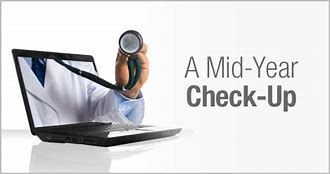5 Steps to a Midyear Financial Review
 Summer is the perfect time for barbeques, but it’s also good opportunity to take the pulse of your saving and spending plan with a midyear financial checkup.
Summer is the perfect time for barbeques, but it’s also good opportunity to take the pulse of your saving and spending plan with a midyear financial checkup.
With the first part of the year in the rearview mirror, a quick look at your monthly budget can yield valuable insight into whether you’re on track to meet your 2021 savings goals. It can also help identify areas of waste and provide motivation to set new goals.
- Check your retirement contributions. Savers should, at minimum, contribute enough to collect any employer match to which they are entitled, he said. Not doing so leaves free money on the table. Ideally, you should aim to max out your tax-favored retirement plans, such as a 401(k) or IRA, which not only helps to build your future nest egg, but also potentially yields a valuable current-year tax deduction. The annual contribution limit for 401(k) plans is $19,500. The total annual contribution limit for Traditional and Roth IRAs this year is $6,000. (That limit is $26,000 and $7,000 for participants age 50 and older.)
- Tackle debt. Next, review your debt. If your debt level going up, you need to understand what’s happening with your financial situation and correct your spending pattern. Some debt, including student loans and home mortgages, are common and necessary, but credit card balances with double digit interest rates can cripple your budget.
- How’s your emergency fund? The mid-year check-up is also an opportune time to be sure your rainy day fund is up to snuff. Most financial professionals recommend having three to six month’s worth of living expenses set aside in a liquid account, such as a money market fund or savings account.
- Monitor your spending. If your debt level has been stagnant since January or you’re finding it tough to meet your savings goals, put the next lazy day to good use and get your budget under control. The National Foundation for Credit Counseling suggests consumers, track their spending for at least 30 days to get a better sense of where their money is going. Look for opportunities to liberate cash flow by halting memberships in clubs you don’t use, slashing your cable bill, and swapping one trip per year for a staycation. Most financial professionals recommend saving 10 to 15 percent of your annual salary for retirement. That’s easiest done by “paying yourself first” through automated deferrals at work.
- Tackle your taxes. Most of us only pay attention to taxes in December, when it’s too late to implement many of the most effective tax-saving strategies. If you meet with your tax professional now, however, you can potentially still maximize deductions. Specifically, financial experts and tax professionals routinely suggest taxpayers check their withholding to be sure they’re on track to pay what they owe and nothing more. Look too, for opportunities to maximize charitable deductions,
The year is still young for those who are serious about getting their financial house in order. By examining your finances or working closely with a financial professional, you can potentially use the remaining months of the year to maximize your tax deductions, eliminate debt, and develop a saving and spending plan that will help you meet your financial goals.
